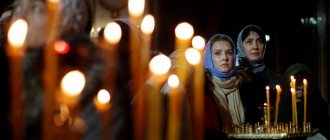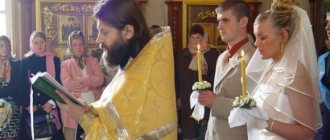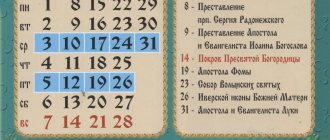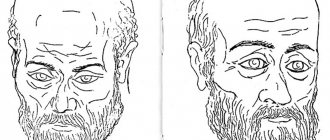In Orthodoxy, there are twelve most significant holidays - these are 12 especially important events of the church calendar, in addition to the main holiday - the great event of Easter.
This number includes both moving holidays and holidays with a fixed date. The most important holiday and celebration of celebrations is the Resurrection of Christ (Easter). We have prepared a complete list of these holidays. The dates of non-moving holidays are indicated according to the Gregorian calendar.
Great Orthodox holidays in 2021 according to the church calendar
The great Orthodox holidays, marked in the church calendar, are divided into movable and immovable. The latter are celebrated on the same date year after year, while you can find out on what dates the former are celebrated only by consulting the calendar. Days of fasting and other important church events are tied to significant dates. Therefore, it is so important to know the calendar of Orthodox holidays for 2021.
Orthodox holidays in 2021 by month
January
- Christmas – 01/07/2020
- Circumcision of the Lord – 01/14/2020
- Epiphany of the Lord – 01/19/2020
February
- Presentation of the Lord – 02/15/2020
April
- Annunciation of the Blessed Virgin Mary – 04/07/2020
- The rise of the Lord to Jerusalem. Palm Sunday – 04/12/2020
- Bright Sunday of Christ. Easter – 04/19/2020
May
- Ascension of the Lord – 05/28/2020
June
- Day of the Holy Trinity. Pentecost – 06/07/2020
July
- Nativity of John the Baptist – 07.07.2020
- Holy Chief Apostles Peter and Paul – 07/12/2020
August
- Transfiguration of the Lord – 08/19/2020
- Dormition of the Blessed Virgin Mary – 08/28/2020
September
- Beheading of John the Baptist – 09/11/2020
- Nativity of the Blessed Virgin Mary – 09.21.2020
- Exaltation of the Holy Cross – 09.27.2020
October
- Intercession of the Blessed Virgin Mary – 10/14/2020
December
- Presentation of the Blessed Virgin Mary into the Temple – 12/4/2020
Week 2 of Lent. St. Gregory Palamas - March 28
Saint Gregory Palamas, Archbishop of Thessaloniki, is one of the greatest theologians and teachers of the Church. His main contribution is the teaching of unceasing prayer, hesychia (silence), uncreated energies and the Light of Tabor. The saint wrote that a believer is able (with God's help) to move away from sin so much as to be rewarded with a real meeting with Christ during his lifetime, to see the uncreated light of Tabor, which was revealed to the apostles on the Mount of Transfiguration.
The Transfiguration is one of the most important events in gospel history (the holiday in honor of it is celebrated by the Church on August 19). One day, Christ, taking with Him the disciples Peter, John and James, went up the mountain to pray. During prayer, His face suddenly changed, and His clothes became sparkling white. The disciples saw that the prophets Moses and Elijah were talking with Him. This amazed the apostles. For a long time, not only the common people, but also the disciples of Christ considered Him primarily an earthly king. On the day of the Transfiguration, the Lord lifted the curtain of the future for them and showed that He is the Son of God. On the icons of the holiday, Christ is usually depicted in a halo of “Taborian light” - the extraordinary radiance that the apostles saw.
Lent is the best time to exercise abstinence and prayer, so in the second week we remember St. Gregory Palamas, who taught that inner transformation is available to each of us.
Calendar of Orthodox fasts in 2021
Multi-day posts
| Name | Dates |
| Great | 2.03.2020 – 18.04.2020 |
| Petrov | 15.06.2020 – 11.07.2020 |
| Uspensky | 14.08.2020 – 27.08.2020 |
| Christmas | 28.11.2020 – 6.01.2021 |
One-day posts
- Every Wednesday and Friday, except for Holy Weeks and Christmastide
- Epiphany Christmas Eve – 01/18/2020
- Beheading of John the Baptist – 09/11/2020
- Exaltation of the Holy Cross – 09.27.2020
What is the meaning of fasting for Orthodox Christians
It would be a mistake to perceive Orthodox fasts as trials and hardships to which believers subject their bodies. In this case, we are talking about the humility of the soul, the movement of a person along the path of spiritual purification.
The fasting calendar is associated with important events in the life of the Church and Great Orthodox holidays. And the restrictions on food and entertainment that believers subject themselves to allow them to remember this and prepare for significant dates.
Week 3 of Lent. Worship of the Cross - April 4
Lent is approaching its mid-point, and believers are beginning to tire of restrictions and intense spiritual life. To encourage them, the Church suggests remembering the purpose of the Lenten struggle. We fast to share His suffering with Christ, and then to more deeply experience the joy of Easter. The focus on this day is the cross, the main Christian symbol.
At the Sunday all-night vigil, the Life-giving Cross of the Lord is brought to the center of the church and remains there until Friday. While singing “We worship Your Cross, O Master, and we glorify Your Holy Resurrection,” believers bow before the cross. The cross reminds us of the suffering of the Savior and strengthens us in our intention to work spiritually in anticipation of Easter. Metropolitan Anthony of Sourozh spoke about it this way: “The Cross is now revealed to us as hope, as confidence in God’s love and in His victory, as confidence that we are so loved that everything is possible.”
Parents' Saturdays in 2021
Parental Saturdays are the days when Orthodox believers commemorate the dead.
On these days, special services are held in churches, and tradition tells Christians to visit the graves of their relatives.
February
- 02/09/2020 – Commemoration of all the departed who suffered during the time of persecution for the faith of Christ
- 02.22.2020 – Meat-fat (Ecumenical)
March
- 03/14/2020 – Second week of Lent
- 03/21/2020 – Third week of Lent
- 03/28/2020 – Fourth week of Lent
April
- 04/28/2020 – Radonitsa
May
- 05/09/2020 – Commemoration of deceased soldiers
June
- 6.06.2020 – Troitskaya
November
- 7.11.2020 – Dmitrievskaya
Read daily memorial dates, names of revered saints every day in 2020 in the story “ Orthodox holidays”
"on "Dni.ru". There you will find the answer to the question of what holiday according to the church calendar is today, and also learn about folk signs, customs and fortune telling associated with this day.
Memory of the 40 Martyrs of Sebaste - March 22
The Forty Martyrs of Sebastia were Christian soldiers who suffered martyrdom in 320 under Emperor Licinius. They were from Cappadocia (eastern modern Turkey) and served as part of the Roman legion stationed in the city of Sebastia.
The commander ordered them to sacrifice to the pagan gods, but the soldiers refused. Then they were stripped and left overnight on a frozen lake. A warm bath was placed nearby to tempt them to renounce Christ. The next morning, one of the warriors could not stand the test and ran to the bathhouse, but there he immediately fell dead. But one of the guards named Aglaius, seeing the fortitude of the martyrs’ spirit, voluntarily undressed and joined them. According to legend, the martyrs did not freeze to death after standing on the ice for many hours. Then the guards broke their legs and then burned them. The charred bones of the martyrs were thrown into the water so that Christians could not bury them. But, as life says, three days later the martyrs appeared in a dream to Bishop Peter of Sebaste and asked to bury their remains. The bishop and several assistants went to the lake and saw that the bones of the martyrs were glowing with a bright light under the water. He collected them and buried them with honor.
The memory of the Forty Martyrs is one of the most revered holidays, therefore on this day the severity of Great Lent is lightened and the Liturgy of the Presanctified Gifts is celebrated.
There is also a folk tradition of preparing “larks” for the Feast of the Forty Martyrs - figurines of birds made from Lenten dough with raisin eyes. These birds symbolize the souls of the martyrs flying away to God.
Week 4 of Lent. Venerable John Climacus (VI century) - April 11
St. John is an ascetic of the sixth century who spent forty years in the feat of silence and prayer. He wrote the spiritual work “The Ladder” - an instruction and guide to spiritual life. In this book, the path of a Christian is presented as a gradual ascent up a ladder (ladder).
“This book shows the most excellent way. Walking this way, we will see that she infallibly guides her subsequent instructions, keeps them unscathed from any stumbling, and presents us with an established ladder, leading from the earthly to the Holy of Holies, at the top of which the God of love is established,” says the “Ladder.”
Annunciation of the Blessed Virgin Mary - April 7
On this day, the Virgin Mary heard the joyful (good) news that She would become the Mother of the Savior of the world.
The Gospel of Luke tells about the event of the Annunciation. It says that in the sixth month after the conception of Saint John the Baptist by righteous Elizabeth, God sent the Archangel Gabriel to the city of Nazareth to the Virgin Mary with the news that she would give birth to the Savior of the world.
Entering Mary, the angel said: “Rejoice, full of grace! The Lord is with You; Blessed are You among women." He also added: “Do not be afraid, Mary, for you have found favor with God; and behold, you will conceive in your womb and give birth to a Son, and you will call His name Jesus. He will be great and will be called the Son of the Most High, and the Lord God will give Him the throne of His father David; and He will reign over the house of Jacob forever, and His kingdom will have no end.” (Luke 1:28-33) The words of the archangel are the first good news from God for humanity after the Fall. Now the connection between man and God, interrupted by the sin of Adam and Eve, has been restored, which means a new page in the history of the human race begins.
The Annunciation is celebrated annually on April 7, nine months before Christmas.
Week 5 of Lent. Venerable Mary of Egypt (VI century) - April 18
At the end of Great Lent, we remember the saint who walked a long path of repentance. The Venerable Mary was born in Alexandria in the middle of the 5th century. At the age of twelve she left home, drawn by a vicious life. For a long time Mary lived in sin: “For seventeen years, and even more, I committed fornication with everyone, not for the sake of a gift or payment, since I did not want to take anything from anyone, but I reasoned that more people would come to me for free and satisfy my lust." But suddenly the Lord turned her to repentance.
This happened when Mary accidentally ended up in Jerusalem and found herself at the Church of the Resurrection of Christ. All people freely entered the temple, but Mary was stopped by an invisible force. So she realized that the Lord did not allow her to enter the holy place.
Mary was overcome with fear and remorse. After that she went inside. The prayer at the Holy Sepulcher changed the sinner: Mary left her past life and went into the Jordan desert. There she spent almost fifty years alone, praying and fasting. In the desert she was met by Elder Zosima from the Jordan Monastery. He talked with the saint and was amazed at her righteousness. He also saw how, during prayer, she rose above the ground and crossed the Jordan on the water as if on dry land. A year later, the elder gave communion to the saint, and a year later, he found her body in the desert and buried her. According to legend, a lion helped him dig his grave.
Saint Seraphim of Sarov said that the difference between a perishing sinner and a sinner who finds the path to salvation is determination. An example of such determination is Mary of Egypt.
The Life of Mary of Egypt is read during services in the fifth week of Great Lent, on Wednesday evening, when Thursday Matins is celebrated in churches, which is usually called the Standing of Mary of Egypt (Standing of Mary).
Lazarev Saturday - April 24
On this day we remember an incredible miracle - the resurrection by Christ of the righteous Lazarus, who had been dead for four days.
The holy righteous Lazarus lived in Bethany and was the brother of Martha and Mary. Christ visited them often. Shortly before Easter, Lazarus fell ill, and the sisters reported this to Christ. Nj Jesus answered: “This disease is not for death, but for the glory of God.” When the Savior came to Bethany. Martha greeted Him with the words: “Lord! If You had been here, my brother would not have died. But even now I know: whatever you ask God will give you,” to which Christ replied: “Your brother will rise again.” Soon Maria and other relatives arrived. Seeing how they grieved, Christ began to cry. Those gathered approached the cave where Lazarus was buried, and Christ ordered the stone covering it to be rolled away. Martha reminded that Lazarus had been buried four days ago, and he stinks. And Christ prayed and cried: “Lazarus, come out!” The deceased Lazarus came out of the tomb, wrapped in burial shrouds on his hands and feet. The Scripture says that many who saw this miracle believed in Jesus Christ, and the Pharisees “from that day decided to kill Him” (John 11:53). The Savior performed a miracle that angered the Pharisees, not only out of love for his deceased friend and his sisters, but also to show people that the general resurrection on the Day of Judgment is a reality.
According to legend, after the Resurrection of Christ, Lazarus left Judea due to persecution. He settled in Cyprus and subsequently became a bishop. After his resurrection, Lazarus lived for about 30 more years.








